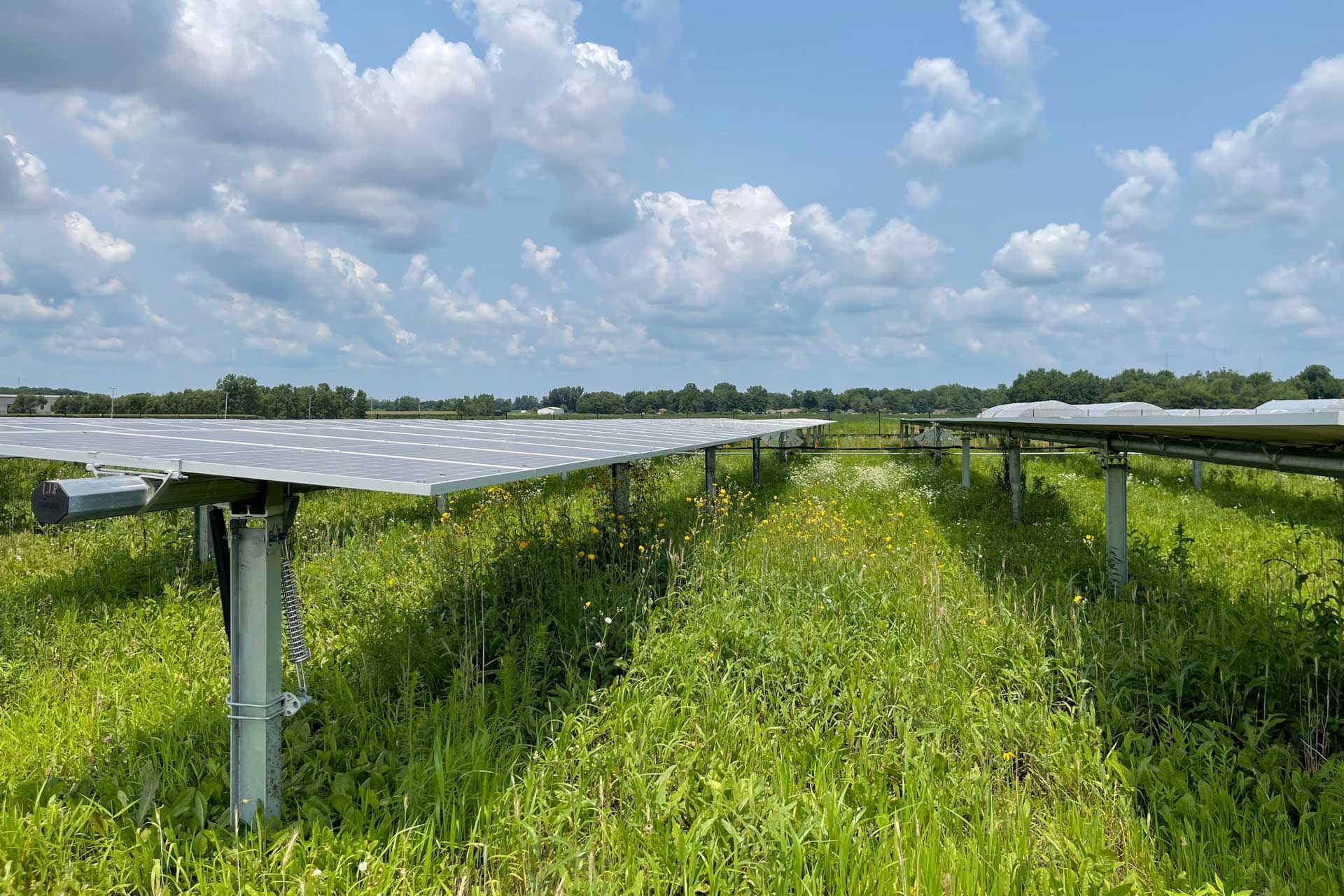Agrivoltaics 101
June 28, 2022

For millennia, farmers have harvested grains, fruits, vegetables, and other agricultural products, providing their nearby communities and people in far-off lands with the necessary resources to support their households. These days, farmers still provide countless families with the produce they need, but now there is another “crop” they can harvest and share: solar energy. Through a setup called agrivoltaics, farmers combine agricultural production and solar energy production on the same land, providing both a bounty of crops and clean energy.
How Does Agrivoltaics Work?
Agrivoltaic designs cater to unique logistical needs as well as landowner preferences. Agrivoltaics can coexist with a variety of land uses, including growing crops, grazing livestock, and even growing native plant species to facilitate pollinator habitats.
Solar panels are designed to be self-contained, making it safe to plant crops right next to them, or even below them. Solar racking, the metal pieces that hold up the solar panels, can be designed to various heights, leaving space for crops of varying heights to be grown beneath. Planting under solar panels offers ideal conditions for produce that need partial shade, such as carrots, potatoes, and greens. Moisture is also held beneath the solar array, reducing or even removing the need for irrigation for the crops.
Different solar racking heights can also be conducive to growing grasses for grazing under solar panels. This can be helpful for farmers wishing to graze their own animals at the site. Alternatively, your solar company can coordinate bringing animals in to graze on a regular rotation, making good use of the land’s capacity for agricultural production.
Agrivoltaics can also play a role in developing pollinator habitats. Growing native plants provides an ecosystem for bees, butterflies, and other crucial pollinators facing dwindling population numbers. In this case, agrivoltaics serves the additional function of habitat restoration and supports the survival of heirloom varieties of native plants.
Just as the agriculture part of the agrivoltaics equation is immensely varied, so is the solar component. Solar development of all types is suitable for agrivoltaics, ranging from large utility-scale solar farms that produce megawatts of power right down to a few small panels in your backyard garden.
While all of these solar options can be suitable for agrivoltaics, the pairing of community solar gardens with agricultural production is especially fruitful. Community solar gardens come in a variety of sizes and locations, and can be customized by the developer to fit unique land use patterns. Additionally, an agrivoltaics model can be appealing to community solar subscribers who hope that their subscription will generate positive environmental and social impacts beyond the renewable energy they generate. Community solar gardens that incorporate agrivoltaics offer a direct positive impact for farmers and can help facilitate sustainable agricultural operations.
Benefits of Agrivoltaics
Part of what makes agrivoltaics a popular option is that it increases land productivity while simultaneously benefiting the environment. However, agrivoltaics also has additional economic and social benefits. The development of solar projects supports jobs in construction, engineering, operations, maintenance, and more. This job creation also has downstream positive effects on the local economy, as solar workers dine in local restaurants and shop at local businesses.
Farmers and ranchers also see direct financial benefits from the land-lease payments they receive for hosting solar projects on their land. Land-lease agreements typically involve a small portion of a landowner’s land and last for 20 to 30 years. The ensuing land-lease payments are especially helpful for farmers and ranchers who have faced low crop yields caused by climate disasters and inconsistent precipitation, rising cost of agricultural inputs, and erratic market pricing on everything from beef to soybeans. With solar, farmers who may struggle to make ends meet solely farming traditional agricultural products can find financial stability by also harvesting sunshine on their land.
Agrivoltaics also offers landowners a way to keep their land in production. Farmers and ranchers face declining land productivity for a variety of reasons, including changing weather patterns, extended drought, and other causes, many of which are linked to climate change. On land where they used to harvest crops, they can now harvest the power of the sun too. Additionally, should conditions become suitable for farming again, it is possible to resume traditional single-land-use farming. After the lease term of a solar garden is up, the equipment is removed for recycling, leaving the land 100% available for agricultural production.
Agrivoltaic configurations also serve double-duty by offering the environmental benefits associated with clean energy. Solar power, particularly when being built as an alternative to fossil fuel power sources, avoids carbon emissions and facilitates cleaner air and water. Deploying renewable energy in agricultural areas is crucial in the fight against climate change, an endeavor that is especially important for farmers who have faced tough years due to climate disasters, inconsistent rainfalls, and erratic weather patterns.
Solar and Agricultural Production: The Perfect Pair
Solar development and agricultural production are an excellent pairing for dual land use, creating economic opportunity and helping the environment. Agrivoltaics is truly good for farmers, good for solar development, and good for all of us. If you’re looking to support or benefit from the extensive positive impacts of agrivoltaics, contact the Pivot team about project opportunities or consider subscribing to a community solar operation.

.jpg?width=123&name=Angie%20Agrivoltaics%20Award%20(HQ).jpg)


.jpg?width=400&name=Angie%20Agrivoltaics%20Award%20(HQ).jpg)
